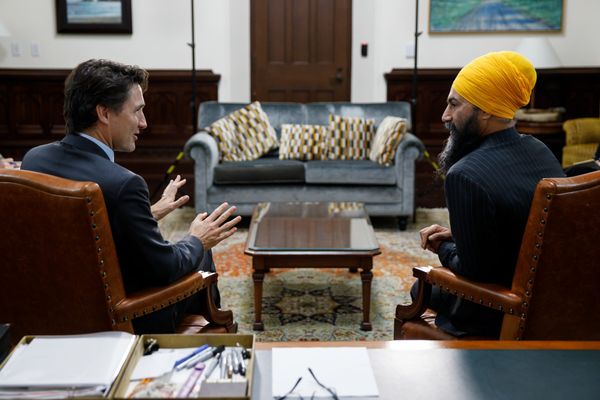For years, it seemed like Tim Hortons’ supremacy in Canada was untouchable. Their brand was woven into the fabric of Canadian identity unlike almost any other. Nothing said Canada quite like the image of a cold rink, an early morning hockey practice and coffee that’s only drinkable when diluted by double milk and sugar.
Canadian identity is tenuous. From the early days of the Hudson’s Bay Company to Canadian Tire, Canadians have used corporate symbols as a proxy to express our identity. But as all things that make up national myths, the romantic and the real are ships passing in the night.
Over the past decade, Tim Hortons has changed ownership, centralized operations to cut costs and targeted its workers. The reputation the company once enjoyed has been tarnished, and the corporate giant is at a crossroads in its own existential crisis.
In 2014, the Brazilian investment firm 3G Capital purchased Tim Hortons for $12.5 billion, merging it with Burger King to form a new company headquartered in Canada, Restaurant Brands International (RBI).
Many Canadians viewed RBI’s acquisition of Tim Hortons as the ultimate betrayal, believing the quintessentially Canadian company was no longer theirs.
This acquisition made Tim Hortons part of the fifth-largest food and beverage consortium in the world. But even though RBI owns Tim Hortons, the vast majority of its restaurants are owned and operated by franchisees. They are responsible for taking care of local HR matters and paying fees and rent to Tim Hortons.
Franchise owners are undoubtedly wealthy, as you must have a net worth of $500,000 and unencumbered access to $100,000 to even pass the franchisee pre-interview process.
Despite intense non-disclosure agreements and little information about how much a franchise makes, there have been a few glimpses into the profits of individual stores. In 2008, court documents revealed that the average annual net income for owners was more than $265,000.
Workers, meanwhile, have suffered as a result of this new business model, in which they find themselves caught between RBI and franchisees, two separate entities that both expect to extract profit from them.
In 2018, Ontario’s minimum wage rose to $14 an hour. Consequently, a war broke out between RBI and the Great White North Franchisee Association, now the Alliance of Canadian Franchisees, a group that represents most Tim Hortons franchisees. RBI refused to allow franchisees to raise their prices in response to the mandatory wage increases, so in an effort to protect their profits, many franchisees cut minor benefits for employees such as paid breaks and free coffee.
In response, rolling protests were held at Tim Hortons’ locations across Ontario, calling for the cuts to be reversed. Unions organized pickets and a social media campaign called “No Timmys Tuesdays.”
When Manitoba’s minimum wage went up in October 2019, workers at a Winnipeg-based store demanded a 30 cents an hour wage increase. This would maintain their previous wage rate, which was 40 cents an hour more than Manitoba’s minimum wage. Franchise owner JP Shearer, who owns seven Tim Hortons stores, responded by locking them out.
There was an outpouring of anger on social media, and a small rally was held comprised of local activists, representatives from several other unions and leader of the Manitoba NDP, Wab Kinew. The employees returned to work on January 10 with a promise from the employer that they will bargain in good faith.
But they’re in for a difficult fight, as wages at Tim Hortons are abysmal. According to Payscale.com, the average salary for food counter attendants in Canada is $11.53, a few cents on both sides of the average minimum wage in Saskatchewan, Manitoba and Atlantic Canada, except Prince Edward Island. As a comparison, Payscale.com has the average wage at McDonald’s at $12.44.
There’s little question that protests impacted Tim Hortons’ popularity. Chris Bourque of Leger surveying told CBC, “The minimum wage war has only one victim and it’s the corporate giant.”
In Leger’s 2018 annual survey into where corporate brands rank among Canadians, Tim Hortons fell to 50th place, and only climbed back to 33rd in 2019, even though it had been at fourth in 2016.
Rick Murray, one of the people who worked on the ranking, noted, “Tim Hortons, a perennial top five brand that we’ve previously believed impervious to issue, has fallen mightily in the court of public opinion.”
As their popularity has slid, sales have also been down, although RBI is still making a substantial profit. In a call with investors after the release of 2019 third quarter results, where sales dropped by 1.4 per cent, RBI CEO José Cil said that Tim Hortons’ performance was “not where we want [it] to be.”
But analysts have blamed this on competition from restaurants with better coffee, and Tim Hortons’ reliance on empty-calorie foods, not the slight increases to the minimum wage.
Recently, an online order for boxes of donuts was made to Oh Doughnuts, a bakery in Winnipeg. The order came from Prime Minister Justin Trudeau, who was looking to spread around a sugar high for his colleagues at a day-long cabinet meeting in the city.
Media outlets reported that some Canadians were mad at Trudeau for choosing a more expensive donut shop over the iconically Canadian and cheap Tim Hortons. Oh Doughnuts argued on Twitter that it’s important to buy local and support bakeries that use local ingredients. They boasted that none of their staff makes minimum wage, and that their donuts are freshly made in-store, not “trucked in frozen from a plant in [Ontario].”
The proliferation of local bakeries like Oh Doughnuts that pay fair wages are a threat to Tim Hortons. Years of cost-cutting has turned Tim Hortons into an option when there’s literally nothing else. But the ease and convenience of a store that’s on every corner makes it hard to avoid sometimes, even if Canadians ranked Tim Hortons coffee last in a recent survey of five chains, where McDonalds’ and Starbucks were on top.
As the chain prepares for 2020, management has decided to go back to what the brand is known for: pastries and coffee that you can pick up in 25 seconds as you pass through the drive-thru.
In a series of town halls with franchisees held in January, reported on by the Financial Post, Tim Hortons management said they will move away from peripheral options like hamburgers and Beyond Meat products, and instead focus on what has made them famous.
As management tinkers with menu innovations and creates ways to ensure that people are processed through the drive-thru as fast as possible, workers are likely to remain in the crosshairs. Unless, like the Winnipeg workers who are fighting for better wages, Tim Hortons and its franchisees face direct confrontation.







